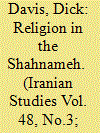| Srl | Item |
| 1 |
ID:
151802


|
|
|
|
|
| Summary/Abstract |
The death of the Persian dynast Rostam b. Farrokh-Hormozd at the Battle of al-Qādisiyyah during the Arab-Islamic conquest of Iran received much attention in both the Islamic conquest literature and the Persian epic tradition canonized in the Shāh-nāmeh. A careful examination of the narratives of early Islamic history teaches us much about the mindset of those living in the first centuries following the momentous events of the seventh century. By removing the layers of literary embellishment and moralistic exegesis, we can understand better the impact of the death of this Sāsānian dynast. In addition, by comparing the narrative traditions, we can uncover valuable testimony regarding the early development of what might later be described as an Islamic Iranian identity.
|
|
|
|
|
|
|
|
|
|
|
|
|
|
|
|
| 2 |
ID:
137387


|
|
|
|
|
| Summary/Abstract |
This article discusses the reasons why Ferdowsi does not begin the Shahnameh with the episode of Zoroaster, which he quotes from the version of Daqiqi, but rather with an account of the creation of the world that, in contrast to Islamic historians writing before Ferdowsi, does not attempt to accommodate a Qur'anic view of creation and human history, but neither does he give a cosmology dominated or well informed by Zoroastrian theology. Similarly, Ferdowsi tends to present pre-Islamic Iran as having a consistent religious history, and perhaps avoids beginning with Goshtāsp's conversion to the religion of Zoroaster, as he makes Daqiqi appear to do, in order to minimize the role of religious conflict in Iranian history, again diverging from historians of the Islamic period writing before him. The article also explores the role of God in the Shahnameh and the absence of theodicy.
|
|
|
|
|
|
|
|
|
|
|
|
|
|
|
|
| 3 |
ID:
141268


|
|
|
|
|
| Summary/Abstract |
In this article I examine the debate over the character of Cyrus the Great in Iran during the last four decades, using it as a prism to view the struggle over the desired balance between religious and ethnic components of Iranian identity. Heated polemics over the historical figure of Cyrus and his legacy reveal undercurrents of Iranian identity dilemmas as well as different and conflicting views of Iranian identity. Beyond a mere historical or religious controversy, the debate over the “right” memory of Cyrus presents an interesting case of shifting emphasis on identity and sources of political inspiration in Iranian society from the late 1960s to the present. Moreover, putting the debate over the ancient king in perspective, there emerges a wider picture of religious adaptation and embrace of what once seemed pagan or secular.
|
|
|
|
|
|
|
|
|
|
|
|
|
|
|
|